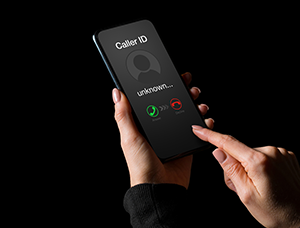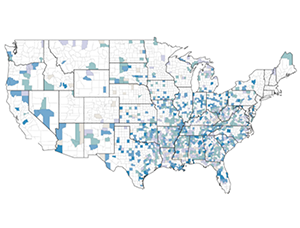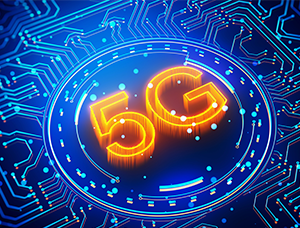For her last Open Meeting, FCC Chairwoman Jessica Rosenworcel gave a final summation on the on the agency’s efforts to expand connectivity and access to modern-day communications. These combined efforts work to ensure that everyone, everywhere has the connections they need for school, healthcare, work, and more.
Watch the Open Meeting here: https://youtu.be/u5veMyNULP0?si=5MDAwyyLVUfFvCrt
Ensuring Everyone, Everywhere Can Participate in The New Digital Age
Under Chairwoman Rosenworcel’s leadership, the FCC prioritized ways to provide affordable and accessible internet for everyone. The Commission achieved this through programs like the Affordable Connectivity Program, clearer consumer information with Broadband Labels, improved accessibility for those with disabilities and on Tribal lands, and better data collection to inform infrastructure investment.
These efforts included:
The Affordable Connectivity Program (ACP): With over 23 million households enrolled across all 50 states, territories, and federally recognized Tribal lands, the success, reach, and impact of the program was unmatched. The ACP was the nation’s largest broadband affordability effort to date.
Launching Broadband Labels: The FCC established labels for broadband providers to display specific information regarding their internet service plans, enabling consumers to make informed decisions when shopping for broadband service.
Modernizing E-Rate & Disability Access: The FCC modernized the E-rate program by expanding eligibility for Wi-Fi hotspots, Wi-Fi on school buses, and to address digital disparities on Tribal lands. It also adopted rules to improve the access and functionality of communications services for people with disabilities such as updating access to video conferencing services and requiring 100% of U.S. mobile wireless handset models to be hearing aid compatible.
Drastically Improving Broadband Data Collection: A cross-agency team worked to develop the most accurate national broadband maps in our nation’s history, enabling the FCC to clearly understand the gaps in the country’s infrastructure and facilitate effective and targeted investments to expand this critical resource. For the first time, the agency was able to produce broadband availability maps that showed data down to the individual serviceable location versus previous maps that stated broadband was available if a single home in a census block could have service.
Ensuring Even the Most Vulnerable Populations Can Stay Connected
Chairwoman Rosenworcel championed important changes and new programs that helped people overcome debilitating isolation, offered new pathways for people to seek help when facing mental health struggles, and advanced broadband technologies to meet people where they are.
These efforts included:
Rapid Implementation of the Martha Wright-Reed Act: The Act gave the Commission new authority to establish meaningful and reasonable limits on the costs of phone and video calls for incarcerated persons. The FCC voted to end exorbitant phone and video call rates that have burdened incarcerated people and their families for decades. Under the new rules, a 15-minute phone call dropped from as high as $11.35 to $0.90 in large jails and from $12.10 to $1.35 in small jails. Video visitation call prices also fell significantly.
Expansion of 988 Suicide and Crisis Lifeline: In addition to phone calls, the service now accommodates text messages, which is critical to making this resource helpful for young people and people who can’t freely communicate over the phone. The agency also mandated georouting for 988 calls, which ensures that people in need are connected to local crisis centers and resources.
Independent Phone Connections for Victims of Domestic Violence: The Safe Connections Act enabled the FCC to require phone providers to separate lines for domestic violence survivors within 48 hours. Now, providers must also omit calls and texts to domestic violence hotlines from consumer logs, and survivors are eligible for subsidized service through the agency’s Lifeline program.
Closing the Homework Gap: Broadband is now more readily available for students and teachers and library patrons through the extension of Wi-Fi hotspot lending programs, the expansion of Wi-Fi on school buses for rural students, and targeted E-Rate program support for Tribal areas.
Helping People Stay Connected During COVID-19: The Commission provided funding for telehealth equipment and systems for hospitals, including rural, tribal, and low-income areas, through the COVID-19 Telehealth Program. The Emergency Connectivity Program supported remote learning, and the Emergency Broadband Benefit Program (later the ACP) provided home internet for low-income households.
Maternal Health Mapping: The FCC implemented the Data Mapping to Save Moms’ Lives Act, which generates maps that provide insight on the intersection of broadband access and maternal health. The Mapping Broadband Health in America platform created, a one-of-a-kind visualization tool for promoting data-driven decision making at the intersection of broadband and health.
Preventing Digital Discrimination: As required by the Bipartisan Infrastructure Law, the Commission formed a task force that focused on creating rules and policies to combat digital discrimination and promote equal access to broadband.
Enhancing Rapid, Efficient, and Nationwide Communications For Our National Defense and Public Safety
Chairwoman Rosenworcel spearheaded efforts to promote network security and reliability and to strengthen 911 and emergency alerting.
These efforts included:
Protecting Communications Supply Chain & Improving Communications During Disasters: The FCC launched the "Rip and Replace" program to remove insecure equipment from Huawei and ZTE, published a "Covered List" of national security threats, and created the U.S. Cyber Trust Mark for consumer IoT products. They also improved wireless network reliability through the Mandatory Disaster Response Initiative, shared real-time outage information with government partners, and expanded the Disaster Information Reporting System.
Strengthening 911 and Other Emergency Services for People in Crisis: The FCC improved 911 call routing, accelerated Next-Generation 911, helped end 911 fee diversion, ensured timely notifications of network disruptions to 911 centers, and ensured officials receive information about 988 Lifeline outages.
Improving Emergency Alerting: The FCC expanded Wireless Emergency Alerts (WEA) to include more languages and a new code for missing persons, advanced location-aware WEA maps, and made Emergency Alert System (EAS) messages clearer. They conducted nationwide EAS and WEA tests with FEMA and assessed WEA accuracy through local tests.
Helping First Responders Communicate in Times of Crisis: The FCC modernized rules for priority service programs, completed the 800 MHz rebanding to improve public safety communications, and solidified the 4.9 GHz band for public safety use.
Issuing Record-Breaking Enforcement Monetary Actions: Over four years, the FCC issued over $340 million in fines across 80 enforcement actions against entities violating FCC rules and jeopardizing consumer safety and national security.
Establishing the First Privacy and Data Protection Task Force: This task force settled data breach investigations with major wireless carriers, issued fines for consumer location data protection failures, and resolved investigations into captioning services and a carrier violating data breach rules and national security agreements.
Getting Creative in the Fight Against Robocalls: The FCC mandated technology to combat spoofing, enabled flagging and blocking of suspicious numbers, issued a fine for AI-generated robocalls, blocked illegal robotexts, issued warnings to facilitators of robocalls, and partnered with states and international entities to combat robocalls.
Promoting the Security and Reliability of Networks: The Enforcement Bureau investigated a cyberattack causing a 911 outage, resolved investigations into submarine cable licenses, and held foreign manufacturers of FCC-authorized equipment accountable.
Protecting Consumers: The FCC eliminated hidden fees and required all-in pricing for cable and satellite TV, mandated public notifications for broadcast TV blackouts, expanded audio description for the visually impaired, explored AI in political advertising, and created the Future of TV initiative to transition from ATSC 1.0 to 3.0.
Enabling a World That Is Innovating Faster Than We Ever Could Have Imagined – and In Many Realms
Chairwoman Rosenworcel created the FCC's new Space Bureau, established future-forward policies to fuel the New Space Age, and led innovative spectrum efforts to enable the next generation of wireless technologies.
These efforts included:
Establishing the Space Bureau: Under Chairwoman Rosenworcel’s leadership and in response to the growing number and novel nature of satellite applications before the Commission, the agency created its first-ever Space Bureau. It is designed to support United States leadership in the space economy, promote long-term technical capacity to address satellite policies, and improve coordination with other agencies on these issues. The FCC is the first telecommunications agency in the world to establish a Space Bureau.
Creating a Single Network Future: The FCC unanimously adopted a new regulatory scheme known as Supplemental Coverage from Space, which made it the first regulator in the world to issue a framework for connecting satellites directly to consumer handsets using spectrum previously allocated only to terrestrial service.
Updating Orbital Debris Mitigation and Space Sustainability Rules: The FCC shortened the amount of time low-earth orbit satellites can remain in orbit following the completion of their missions from 25 years to five years. The Enforcement Bureau also issued the first fine to a company that failed to comply with its orbital debris mitigation plan.
Dedicating Spectrum to Support Satellite Broadband Service and Novel Spectrum Use: The FCC opened the 17 GHz band for shared use by satellites in various orbits, increasing capacity for broadband services and low-latency applications. They also refined rules for spectrum sharing between satellite systems, prioritizing earlier approvals while allowing new entrants.
Mid-Band Spectrum for 5G: To expand 5G availability, the FCC completed service rules for the 3.45 GHz band (raising $23 billion in auctions) and adopted rules for the 70/80/90 GHz bands to facilitate 5G backhaul and broadband on aircraft and ships. They also launched the Enhanced Competition Incentive Program to promote spectrum sharing and the 2.5 GHz Rural Tribal Priority Window, granting licenses to over 430 Tribes.
Making Spectrum Available for Drones, Commercial Space Launches, Public Safety Missions, and Vehicle Transportation: The FCC made the 5 GHz band available for drones, allocated spectrum for commercial space launches, ensured efficient use of the 4.9 GHz band for public safety, and promoted the 5.9 GHz band for vehicle-to-everything technology.
Expanding the Tools for Multiple Spectrum Uses to Co-Exist: The FCC expanded co-existence of spectrum uses in the 3.5 GHz band, increasing uninterrupted access for 72 million people. They also explored enhancing spectrum use in the Lower 37 GHz band through new data sources and AI.
Increasing Spectrum for Unlicensed Devices: The FCC expanded unlicensed access in the 6 GHz band by 1,200 megahertz to support Wi-Fi 6E and future Wi-Fi versions. They also adopted 60 GHz band rules, expanding unlicensed use for high-tech radar applications (like vehicle safety) and drone applications.
Using Every Resource Available to Meet the FCC’s Mission: The Office of the Managing Director led the reorganization process for establishing the Space Bureau and Office of International Affairs, a feat that required immense internal coordination and Congressional approval.
Other Key Initiatives

Homework Gap and Connectivity Divide
Nearly 17 million school children lacked internet access at home, creating a nationwide Homework Gap that, left unsolved, could have become an opportunity gap. Chairwoman Rosenworcel, who coined the term Homework Gap, long advocated for programs to support students left offline because they couldn't access or afford broadband services.

Fighting Robocalls & Spoofing
The FCC’s Robocall Response Team was created by Chairwoman Rosenworcel to serve as an FCC staff working group that pulls together expertise from across the agency to leverage the talents of enforcers, attorneys, policy makers, engineers, economists, and outreach experts to combat the unyielding menace of illegal spoofed, scam, robocalls and robotexts.

Privacy and Data Protection Task Force
Chairwoman Rosenworcel created the FCC’s Privacy and Data Protection Task Force, led by the Chief of the FCC’s Enforcement Bureau, to coordinate across the agency on the rulemaking, enforcement, and public awareness needs in the privacy and data protection sectors, including data breaches (such as those involving telecommunications providers) and vulnerabilities involving third-party vendors that service regulated communications providers.

Net Neutrality
Net Neutrality policies are a national standard by which the FCC ensures that broadband internet service is treated as an essential service. It prohibits internet service providers from blocking, throttling, or engaging in paid prioritization of lawful content. By classifying broadband service as a “telecommunications” service under Title II of the law, the FCC restored its oversight of internet service outages, national security threats in broadband networks, and consumer protection and regains key tools to promote broadband deployment.

Combatting Digital Discrimination
Chairwoman Rosenworcel established the FCC’s Task Force to Prevent Digital Discrimination to address digital discrimination and promote equal access to broadband. This included developing rules and policies to combat digital redlining and improve the consumer complaint process to better address concerns about digital discrimination.

Rural Broadband Accountability Plan
Chairwoman Rosenworcel established the Rural Broadband Accountability Plan, a new effort to monitor and ensure compliance for universal service high-cost programs including the Rural Digital Opportunity Fund and Connect America Fund Phase II Auction. The FCC’s high-cost universal service program approved billions of new investment dollars to bring connectivity to consumers in areas lacking access to broadband.

Broadband Data Collection
To build a digital future for everyone, The FCC under Chairwoman Rosenworcel implemented the Broadband DATA Act, resulting in the most accurate broadband availability data to date. This location-by-location data is publicly available on the National Broadband Map and is continually refined through challenges from stakeholders and FCC verification efforts. This ongoing process ensures the map is constantly improving, informing our work to connect everyone with high-speed broadband.

5G Leadership
Former Chairwoman Rosenworcel championed efforts to position the United States as a global leader in 5G technology. She expanded access to spectrum, modernized infrastructure policies to drive network investment, and advanced initiatives like the 5G Fund for Rural America and Open Radio Access Networks. Her leadership prioritized innovation, security, and connectivity to build a digital future for all.

Telehealth
Nowhere is bridging the digital divide more critical than in the area of healthcare. We live in a world where people can receive care no matter where they live via smartphones, tablets, or other remote devices. These connected care services can lead to better health outcomes and significant cost savings for both patients and healthcare providers. Guided by Chairwoman Rosenworcel’s leadership, the FCC has made expanding access to telehealth services – especially for underserved and marginalized communities – a top priority.

Coronavirus
During the COVID-19 pandemic, Chairwoman Rosenworcel prioritized ways to ensure the American people could stay connected by establishing the Emergency Broadband Benefit, the COVID-19 Telehealth Program, and the Emergency Connectivity Fund.